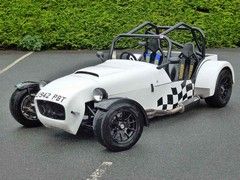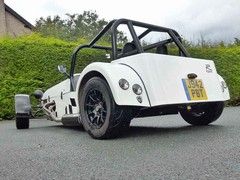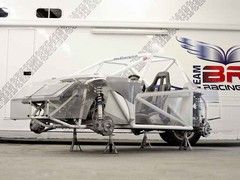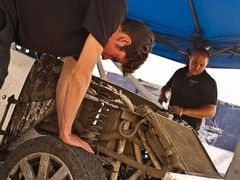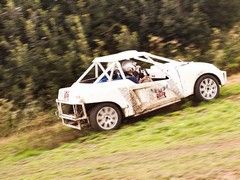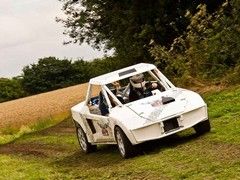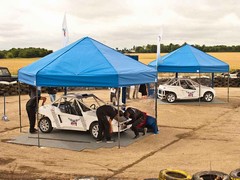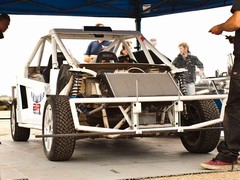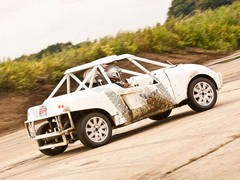Car set-up basics: part one
Back to school for PH's man as he gets to grips with the fundamentals of car set-up
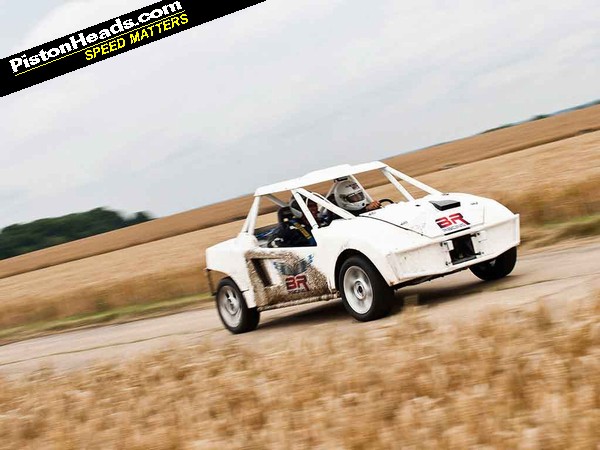
I am very much that amateur track driver with limited knowledge on how to set a car up. So can improving your grounding in this area actually make you faster and, if so, where do you start?
I own a 'Seven-a-like'. You see, I couldn't afford a proper Caterham (still can't...) and wanted something with decent performance, so I went down the bike-engined route and chose an MK Indy R.
While the powertrain might be a contentious issue for some, it's the chassis I bought it for. It boasts plenty of adjustability - camber, caster, spring preload, ride height, as well as compression and rebound damping - which gives two possible outcomes: deriving the perfect setup for your chosen track, or tying yourself in knots when it comes to clicks and turns.
That's why I took a trip to BR Racing's Essex base to get a better idea. The company will soon run experience days for enthusiasts, teaching and showing them the difference between good and bad car set-up on track with extreme understeer and oversteer, for example. They'll run through the different adjustable parts, what they do and how altering them affects the car. So that's a good place for me to begin.
Going sideways
My first run in the car was a disaster - but it was meant to be. I was going sideways everywhere, and not in the manner you might expect from PH...
The team had set the car up to crab badly, hunting for cambers and pulling the wheel in your hands. It's the perfect example of how not to do it and rams home how bad car set-up can lose you time. A quick exploration lap was enough, so back to the pits it was to make some changes.
The Ford-built tubular spaceframe cars the firm uses were originally developed to help train racing drivers, allowing massive geometry changes to show future stars how different parameters can effect car behaviour.
BR Racing has kept that aspect, throwing into the mix a set of GAZ coilovers - adjustable for compression and rebound damping - a bigger 125hp 1.7-litre Ford motor (enough for a 650kg car) and a Quaife ATB limited-slip diff.
Back to basics
Back in the paddock and it's sucking eggs time with a general recap of areas I can adjust. And let's not be squeamish - this is real back to basics stuff. First up, camber. This is the angle the wheel makes to the vertical - for track driving, negative camber (where the wheels lean 'in' towards the car) is generally what you're looking for.
Next up is toe. Toe in (tyres pointing towards each other) gives extra stability, while toe out gives improved turn in.
Ride height does exactly what it says on the tin - by making the car sit higher at the back, say, you effectively put more weight over the front end, aiding grip to neutralise understeer.
Compression and rebound damping control the rate at which the wheel moves up and how quickly or slowly it returns to its equilibrium position. Think of it like pumping iron in the gym - you've got to be as smooth and controlled lifting the weight as lowering it. Your suspension needs to do the same. It's all about keeping the tyre in contact with the road surface, that way it can find the most grip possible.
Neutral ground
Zero is a good place to work from when you're trying to find a set-up. So with neutral settings dialled in (no camber, zero toe, even ride height all round and the dampers in the middle of their range of adjustment) it's back onto the course. Immediately it's better.
The surface is a mix of concrete, mud and grass, so it's always going to be a compromise, but turn in feels positive. The car's too soft on the rear, however - through high speed direction changes there's a fair amount of weight transfer causing the car to lapse into roll oversteer and initiate some big tank slappers. My passenger, James Saggers, former British GT driver and Radical SR4 champion nips out for a spin and (broadly) agrees with what I'm saying, so if nothing else, I've learnt how to diagnose a problem. Now, how to fix it?
I'm interloping a student day, where motorsport and engineering colleges come to learn about set-up, too. Following Saggers' feedback the students dial in six clicks of damping on the front and 10 at the rear to make it firmer, while dropping the rear tyre pressures by 2psi when hot.
The rear is better but the front is now worse, locking up on the brakes on the loose and the bumpy concrete. It's more unsettled on turn in as well and there's less compliance. More air out of the tyres to 28psi from 34 (it's amazing what difference this makes) and three fewer clicks on the front dampers yield an improvement, but it's still not perfect.
Maybe it's time to think about some geometry changes, then? More rake (higher rear ride height) and some more negative camber on the front would certainly improve things, but I'm only here for a taster session and I don't get to weigh up the difference.
No matter though. What's important is the knowledge I've gained - something that experience day punters will pick up, too. And now I'm free to transfer it to my car and experiment with it. I'll be breaking out the spanners on the MK this weekend, so stay tuned for the results. It's going to be fun.
and leaving of the pies
My typical day for dialing in suspension settings: First off I've got an Aventador with uprated suspension, brakes, wider tires, lighter alloys, the lot, etc. I'll go to my favourite track (usually Silverstone); add 2 degrees of negative camber at the front, lower the front suspension until it bottoms out put a small amount of toe out on the front and a little bit of toe in at the rear.
I'll do 3 or 4 laps, take a note of my lap times, press start and rinse and repeat until the best combination is found. Would be fun in real life I guess...
and leaving of the pies
What people are these? You must hang out with some clueless car people because the people I know who buy 'go fast bits' either know what they're doing with them, or they get a pro to set them up (and possibly fit them too).
and leaving of the pies
What people are these? You must hang out with some clueless car people because the people I know who buy 'go fast bits' either know what they're doing with them, or they get a pro to set them up (and possibly fit them too).
The clueless will soon realise their tracking is wrong when the tyres wear.
Would be good to see a follow up to this in your results with the MK. Of course balancing the shocks and having the correct spring rate is also an important part of the setup - you want to adjust the car from the ground up first rather than eventually find out after ten trackdays fighting to find the optimum setup that your spring rate and damper calibration was wrong to begin with.
This makes sense for the rear wheels. However at the front, surely toe-in will give better turn-in, while toe-out will give more stability? The front outside wheel is where the weight goes as you turn in, so having that pointing in would exaggerate the turning movement, whereas having it pointing out would reduce it, I'd have thought?

Well the last go-kart I tried didn't have any springs and felt like my teeth were going to fall out over the slightest bump....
Seriously, a few years ago on one particular forum I had a bit of a crusade about geometry, set-up and 'over' lowering - did it work? no, they went for the 'look' rather than the handling....
This makes sense for the rear wheels. However at the front, surely toe-in will give better turn-in, while toe-out will give more stability? The front outside wheel is where the weight goes as you turn in, so having that pointing in would exaggerate the turning movement, whereas having it pointing out would reduce it, I'd have thought?
The difference of toe in and toe out on track also becomes apparent when you look at steering angles on turn in - with toe in, the inside wheel pushes against the turn because it has a lower steering angle than the outside wheel. The outside wheel has more work to do so overall so the front of the car loses grip earlier.
With toe out this works in the opposite sense, where the inside wheel in simple terms is trying to drag the car in towards the apex at turn in, rather than push the front wide. The outside, loaded wheel is being helped by the greater steering angle of the inside front wheel.
Even something as simple as lowering springs can affect damper efficacy because the damper stroke is being reduced. Again most people don't get this.
As I said, best left to the experts IMO.
Uprated suspension packages are available for 99% of the cars on the road and it certainly seems way more common than when I started driving. In fact, when I had my first car it was more common to jack the rear suspension up and shine a red light on the diff, than actually do anything that would improve handling!
Gassing Station | General Gassing | Top of Page | What's New | My Stuff

